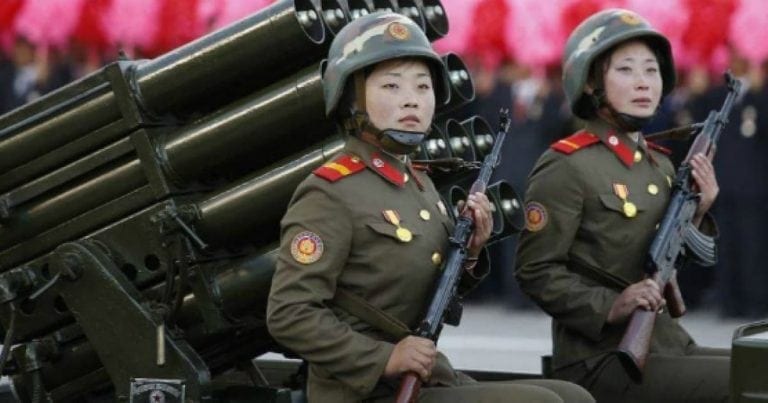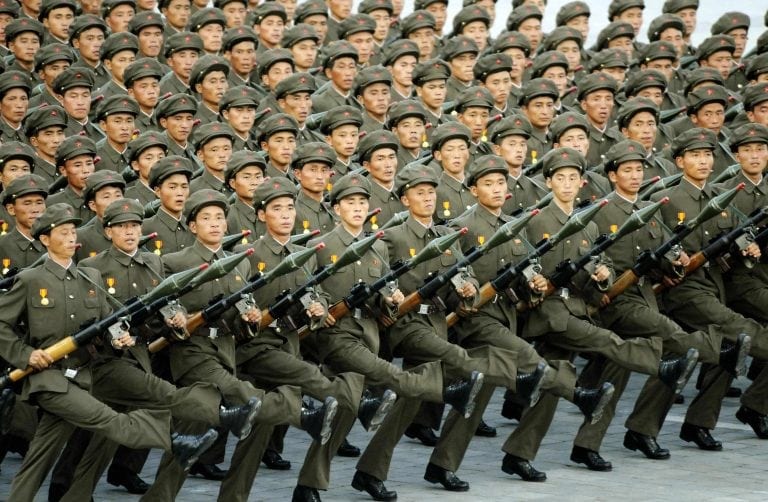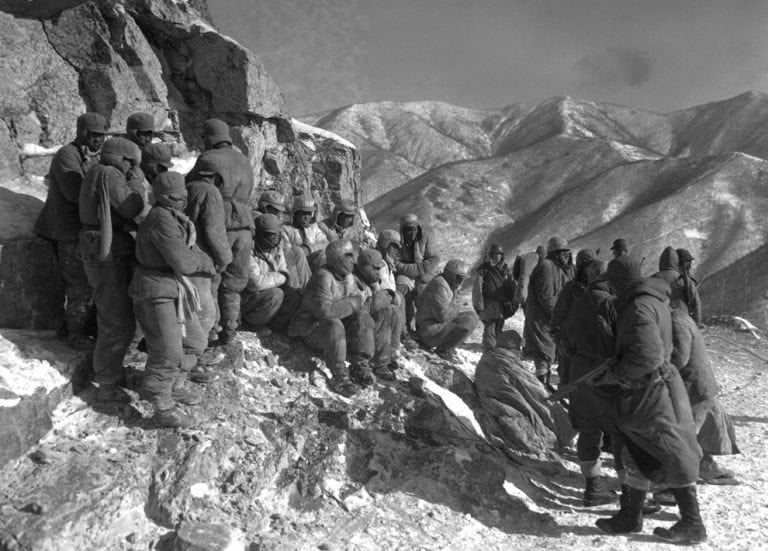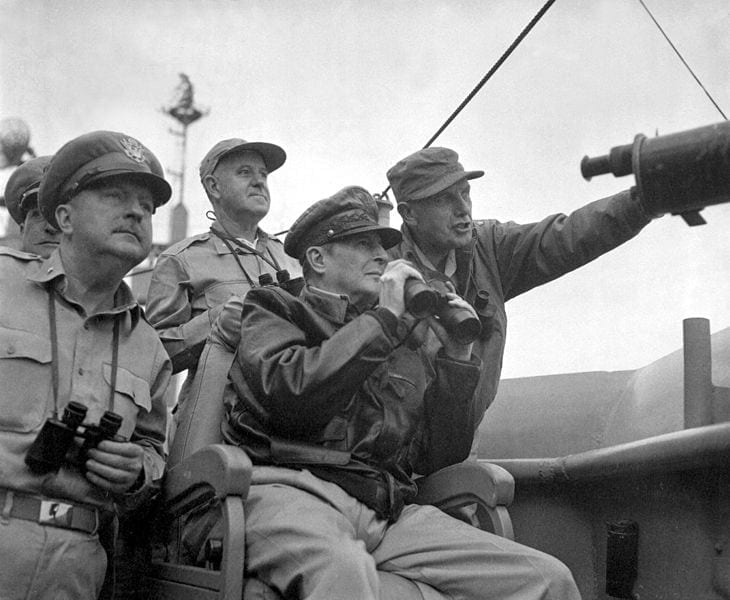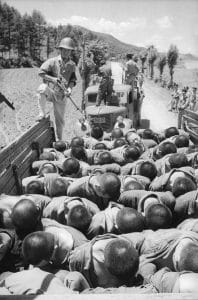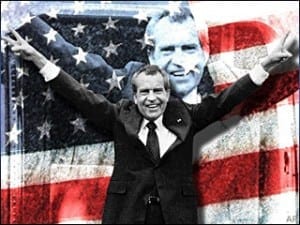North Korea today is not the North Korea of 1994 when President Bill Clinton seriously considered a preemptive strike against the Yongbyon nuclear reactor. Back then North Korea did not possess any nuclear weapons.
Now North Korea possesses the knowledge of nuclear weapons technology and any US cyberattacks can only slow the process of weapons development but not stop it. Most likely the North’s ability to reconstitute nuclear weapons technology is there for good — and it is proceeding with ICBM experiments too.
David Sanger ran an interesting article, “Trump Inherits a Secret Cyberwar against North Korean Missiles” (New York Times, March 4, 2017). In 2014, the Obama administration ordered Pentagon officials to step up their cyber and electronic strikes against North Korea’s missile program. “Soon a large number of the North’s military rockets began to explode, veer off course, disintegrate in midair and plunge into the sea.”
Upon close examination, however, “Pentagon’s disruption effort, based on interviews with officials of the Obama and Trump administrations, found that the United States still does not have the ability to effectively counter the North Korean missile program.”
Despite Trump’s saying “It won’t happen!,” North Korea will continue to develop its nuclear weapons technology. Trump may consider direct missile strikes on the launch sites as did Obama, but there is little chance of hitting every target.
Iran found out about the US and Israeli-led sabotage of its nuclear program using the “Stuxnet” worm, and effectively countered it (as well as cyberattacking Saudi Arabia’s oil field computers). Iran was a comparatively easy target, though. Sanger notes that in North Korea, missiles are fired from multiple launch sites around the country and moved about on mobile launchers in an elaborate shell game meant to deceive adversaries.
Bruce Cummings tells us that for decades the North has built some 15,000 underground facilities of a national security nature. In the mountainous terrain, sometimes a mile deep, are hidden nuclear weapons facilities as well as conventional weapons such as long-range canons. See “Advocates Urge Trump to De-escalate with North Korea, Not Ratchet Up Threats & Military Aggression” (Democracy Now! April 17, 2017) with guests Bruce Cummings, and Christine Hong.)
The North does not want war. Neither do South Korea and China. There will be a war only if US wants it.
North Korea seems to have figured out how to deal with cyberattacks. In April and September last year North Korea had successes with R-27 engines and exploded nuclear weapons with more than twice the destructive force of the Hiroshima bomb.
A report on cyber vulnerabilities by the Defense Science Board, commissioned by the Pentagon during the Obama administration, warned that “North Korea might acquire the ability to cripple the American power grid and it could never be allowed to ‘hold vital U.S. strike systems at risk’.” We know that, in 2014, North Korea messed with Sony Pictures Entertainment wiping out 70 percent of the company’s computing systems. Ted Koppel’s work, Lights Out: A Cyberattack, A Nation Unprepared, Surviving the Aftermath (Crown, 2015) deals with cyberwar and its limits.
Once the US uses cyberweapons against nuclear launch systems of North Korea, Sanger notes, Russia and China may feel free to do the same, targeting American missiles. “Some strategists argue that all nuclear systems should be off-limits for cyberattack. Otherwise, if a nuclear power thought it could secretly disable an adversary’s atomic controls, it might be more tempted to take the risk of launching a pre-emptive attack.”
America’s Red Line vs. North Korea’s Red Line
The US will draw a line if and when a North Korean ICBM is capable of reaching the US mainland.
North Korea is two or more years away from successfully achieving such capability. It has yet to figure out how to solve the problems of 1) miniaturizing the nuclear warheads and 2) re-entry from space.
Joshua Pollock, a senior researcher at the Middlebury Institute of International studies in Monterey, CA, thinks that the North’s ICBM tests will allow them to work through problems of 1) and 2) and the North will be able to create a reliable weapon in a “year or two.” (North Korea nuclear threat: should California start panicking? By Alan Yuhas, The Guardian, April 20, 2017.)
Joseph Bermudez, an analyst at 38 North, a think tank affiliated with the Johns Hopkins School of Advanced International Studies, said, “If everything proceeds as is, It’s likely by 2020 that they could have a system reaching the United States.”
After the fifth test last fall, Siegfried Hecker, the former director of Los Alamos National Lab, thought likewise: “Left unchecked, Pyongyang will likely develop the capacity to reach the continental United States with a nuclear tipped missile in a decade or so.”
Bermudez observed, “It’s likely that any cyberwarfare campaign would not be able to stop either the nuclear program or the ballistic program, only delay it.” (Yuhan, The Guardian. Emphasis added).
Pollack argues that the good news is North Koreans are not suicidal and they are not going to just start a war. As any other country, North Korean wants to survive as a nation.
The North does not want war. Neither do South Korea and China. There will be a war only if US wants it.
Max Fisher points out the dilemma in “The North Korea Paradox: Why There are No Good Options,” New York Times, (April 17, 2017). He writes, “The United States’ relative strength is also paradoxically, a weakness. North Korea knows that it would quickly succumb to a full American attack, making its only option to escalate to nuclear strikes almost immediately at the start of a conflict.” (italics added). It’s a hair trigger to nuclear escalation.
The North’s goals are: 1) recognition of the Democratic People’s Republic of Korea (DPRK) as a legitimate political entity and a nuclear state; 2) stopping the US conspiracy of regime change, biannual “decapitation” exercises along with South Korean military; 3) lifting sanctions; and 4) replacing the armistice of 1953 with a permanent peace treaty.
Should the US engage in a pre-emptive strike, it would not be truly “pre-emptive” in that the word pre-emption means “action taken to check other action beforehand.” The initial first strike against the North would not eliminate all North Korean military targets, such as 15,000 tunnel complexes – some of which are located mile deep under rugged mountains. And even if the US did intercept the North’s ballistic missiles in midflight with an anti-missile system (such as THAAD), the North would retaliate not only with nuclear but also with conventional weapons.
William Perry, former US Secretary of Defense, remarked (April 14 edition of the LA Times): “I think with high confidence, there is going to be a military reaction from North Korea. Not a nuclear attack as they threatened, [but] rather a conventional but still quite destructive attack against South Korea.” There are approximately 20 million people in the greater Seoul area. Moreover, the North has the military hardware to attack Tokyo, Okinawa, and more than 80,000 US military personnel in South Korea and Japan.
In the same article, Leon Panetta, who served as Secretary of Defense under Obama administration, warning against Trump raising tensions, said, “We have the potential for a nuclear war that would take millions of lives. So I think we have got to exercise some care here.”
Christine Ahn writes, “Any military action by Washington will undoubtedly trigger a counter-reaction from Pyongyang that could instantly kill a third of the South Korean population.” (“The High Costs of US War Mongering Against North Korea,” by Christine Ahn, Truthout, April 26, 2017.)
We are not talking about tossing around nukes with 15 kilotons (Hiroshima) or 18 kilotons (Nagasaki); the most common nuclear weapon in the US arsenal today, the W76, packs an explosive power of 100 kt. The next most common, the W88, packs a 475-kilotont punch.
Conn Hallinan describes a scene: “A recent study found that a nuclear war between India and Pakistan using Hiroshima-sized weapons would generate a nuclear winter that would make it impossible to grow wheat in Russia and Canada and cut the Asian Monsoon’s rainfall by 10 percent. The result would be up to 100 million deaths by starvation. Imagine what the outcome would be if the weapons were the size used by Russia, China, or the U.S.” (“America’s New Nuclear Missile Endangers the World, by Conn Hallinan”, Counterpunch, April 28, 2017.)
The red line for North Korea is: sovereignty and self-determination. And if it takes nuclear weapons to deter the great powers, so be it.
Rarely do we see North Korea openly critical of China. Kim Chol’s angry remarks carried by the official Korean Central News Agency on Wednesday May 3 as president Trump was pressuring China to increase the pain inflicted on North Korea was thus unusual: “One must clearly understand that the D.P.R.K.’s line of access to nukes for the existence and development of the country can neither be changed nor shaken… And that the D.P.R.K. [Democratic People’s Republic of Korea] will never beg for the maintenance of friendship with China, risking its nuclear program which is as precious as its own life, no matter how valuable the friendship is.” The North accused China of making “lame excuses for the base acts of dancing to the tune of the U.S.” (North Korean Media, in Rare Critique of China, Says Nuclear Program Will Continue”, by Choe Sang-hun, New York Times, May 4, 2017.)
Kim Jung-un, being “a smart kid,” as Trump called him, is well aware of what happened to Muammar al-Qaddafi of Libya and Saddam Hussein of Iraq for having surrendered their nuclear weapons programs. As Hillary Clinton put it, “I came, I saw, and he [al-Qaddafi] died.” She is no Julius Caesar but decided to co-opt his famous “veni, vidi, vici.”
Interestingly, Moon Jae-in, the most likely next president of the Republic of Korea (South Korea) is also saying that South Korea needs to say no to the United States. That is also unusual. Moon’s advocacy of “[South Korean] National Interest First” policy is striking a responsive chord among the voters.
Moon is calling for 1) renegotiating the THAAD agreement of the recently impeached Park Geun-hye’s administration with the US; 2) renegotiating the Operational War Time Control (OPCON) policy, a fundamental anomaly whereby the US nullified South Korea’s sovereignty by being a hegemonic overlord controlling the South’s military dating back to the beginning of the Korean War under the fig leaf of the UN Command; and 3) renegotiating Park Geun-hye administration’s “comfort women” agreement with Japan. (See also “The United States Should Listen to South Korea – or It Will Reap the Whirlwind,” by Tim Shorrock, The Nation, May 5, 2017.)
Jason Lim, a 36-year-old South Korean engineer living in Washington, DC, thinks “it’s important to try and maintain a solid alliance with the United States – but not at any cost…”
Lim and many South Koreans say their country has been reduced to a pawn in a superpower game of chess as the United States and China seek to tackle North Korea’s advancing nuclear and missile programs.
“What none of the policy papers address is the role that South Korea has to play. It is simply assumed that the status quo will continue, and South Korea will go along with any action the U.S. chooses to take, no matter how harsh or dangerous. In the mind of the Washington Establishment, this is a master-servant relationship and nothing more.” (“US-North Korean Relationships in a Time of Change,” by Gregory Elich, Counterpunch, February 13, 2017.)

Obviously, the arrogant West, and the Americans in particular, fail to understand how deeply the people of North Korea identify with their leaders, all product of a long, painful and complex struggle. (Click on image)
Both North Korea (DPRK) and South Korea (ROK) are saying, “We have had enough of ‘serving the powerful’ (sadaejuuyi).” A good many South Koreans are seriously fatigued by 72 years of “You gotta behave” from September 1945 to the present day.
In 2004 I was at a university in Seoul to teach for a semester and was told by the university that I should never, never criticize the United States.
In an interview with Hankyoreh (Hani), John Delury, Associate Professor of Chinese Studies, Yonsei University , Seoul, Korea, was asked: “Do you think the North Korea nuclear and missile threats could come to an end by just pressing the North to the maximum level and imposing tougher sanctions?”
Delury replied: “Thinking that it’s a matter of making North Korea hurt enough shows a fundamental misunderstanding of a key attribute of the DPRK state and society which has an extraordinary capacity to absorb pain. They have maybe suffered more than anyone since 1945. They’re like a boxer, they’ll never beat you but you can never knock them down. No matter how hard you hit them, they get back up.” ([Interview] “Can candlelight energy spark new era of inter-Korean relations?“ Hankyoreh, (April 11, 2017).
To understand the mindset of North Koreans — and indeed many South Koreans — one needs to have a historical knowledge of the horrendous Holocaust that took place during the Korean War, 1950-53 – something few US citizens are aware of.
As Air Force General Curtis LeMay put it, “Over a period of three-and-a-half or four years [actually, thirty-seven months] we did burn down every town in North Korea and every town in South Korea…and what? Killed off 20 percent of the Korean population…What I’m trying to say is if once you make a decision to use military force to solve your problem, then you ought to use it and use too much so that you don’t make an error on the other side and not quite have enough. And you roll over everything to start with and you close it down just like that.” (Thomas Coffey, Iron Eagle: The Turbulent Life of General Curtis LeMay, (NY: Crown publishers, 1986, p. 306.)
The Holocaust exterminated 4.610,000 Koreans, mostly civilians, as noted in the Encyclopedia Britannica, 1967 edition, vol. 13, p. 475. Of the 4.6 million, 3 million North Koreans out of 9 million population were massacred. North Koreans defiantly swear “Never again!”
If such a slaughter had taken place in the United States back in 1950, it would have meant 30,454,200 Americans killed — or 20 percent of the U.S. population at that time of 152, 271,417.
Here is a brief excerpt from I. F. Stone’s The Hidden History of the Korean War:
Senator Stennis: “Now as a matter of fact, Northern Korea has been virtually destroyed, hasn’t it? Those cities have been virtually destroyed.”
General O’Donnell: “Oh, yes, we did it all later anyhow…I would say that the entire, almost the entire Korean peninsula is just a terrible mess. Everything is destroyed. There is nothing standing worthy of the name… Just before the Chinese came in we were grounded. There were no more targets in Korea.” (I. F. Stone, The Hidden History of the Korean War, NY: Monthly Review Press, 1971, pp. 312-13.)
Bruce Cummings reflects on war and memory: “’War is a stern teacher,” Thucydides wrote. Indeed it is the supreme teacher of one’s memory. As Nietzsche put the point in discussing humanmnemotechnics, the oldest psychology on earth is that which must be burned in: ‘only that which never ceases to hurt stays in the memory.’” (Bruce Cumings, North Korean, Another Country, p. 26. Cumings relates Nietzsche’s thoughts from Frederick Nietzsche, On the Genealogy of morals (NY: Vintage Books, 1969), p. 61,)
As a 14-year old refugee, I still vividly remember the images of the horrific carnage and destruction during the desperate years of the Korean War because they were burned into my memory – after all these years. Especially in North Korea, these stark memories have been passed on to the new generations.
THAAD
As Gregory Elich cogently argues in his “Threat to China: Pressure on South Korea to Join U.S. Anti-Ballistic Missile Defense System” (Global Research, July 1, 2014), South Korea really does not need a THAAD battery, as a Pentagon official admitted. It is not relevant to South Korea’s defense against North Korea’s attack because of the short distances between the North and targets in the South.
A THAAD battery that the US is deploying in South Korea – in the stealth of night with 8,000 Korean security police to guard against protesting South Koreans – is intended to detect and track as early as possible China’s ICBMs, tipped with MIRV payloads and headed for the West and East Coast of the US.
This US initiative boils down to the US trying to squeeze one billion dollars out of South Korea’s treasury for installing a THAAD missile defense that South Korea does not need – in addition to $880 million per year that South Korea already pays for maintaining approximately one hundred permanent US bases in South Korea.
As scientists Postol and Lewis warmed, THAAD in Seongju, South Korea, may well be the first place targeted by China before Beijing launches any ICBM attack against the US mainland, thereby making South Korea not more but less safe.
Why is “Pivot to Asia” important to the US?
The US policy of “Pivot to Asia” is primarily preoccupied with the military potential and development of China. THAAD is an important part of the US effort to surround China and Eurasian heartland with hundred of military bases.
Mike Whitney writes, “It means the United States has embarked on an ambitious plan to extend its military grip and market power over the Eurasian landmass, thus securing its position as the world’s only superpower into the next century.” (“Blood in the Water: The Trump Revolution Ends in a Whimper,” by Mike Whitney, Counterpunch, February 17, 2017.)
His reference to Hillary Clinton’s “America’s Pacific Century” passages are worth quoting because they reflect the thinking of the foreign policy elites, especially the Council on Foreign Relations. (“America’s Pacific Century, Secretary of State Hillary Clinton,” Foreign Policy, October 11, 2011.)
“Harnessing Asia’s growth and dynamism is central to American economic and strategic interests… Open markets in Asia provide the United States with unprecedented opportunities for investment, trade, and access to cutting-edge technology… American firms (need) to tap into the vast and growing consumer base in Asia…
“The region already generates more than half of global output and nearly half of global trade… We are looking for opportunities to do even more business in Asia… and our investment opportunities in Asia’s dynamic markets.”
The Rand Corporation came up with a study entitled War with China: Thinking through the Unthinkable, by David C. Compert, Ahtrid Stuth Cevalles, Ccristina L. Grafola, 2016.
That Rand study recommends that the US duke it out with China before 2026. By then China will already have much further developed its military technology, and later on it could be difficult for the US to prevail in a military confrontation, especially given the economic trends of China vis-à-vis the US by that time.
Robert Gordon argues in The Rise and Fall of American Growth: The US Standard of Living since the Civil War (Princeton University Press, 2016.) that the Golden Age of American growth was from 1870 to 1970. It was an exceptional and truly remarkable century of American prosperity.
For the next 25 years, the US needs to grapple with a number of headwinds – such as 1) rising inequality; 2) poor-quality education; 3) the aging population; and 4) rising government debt. He might have added political paralysis and corruption of the Washington swamp and the cancer of Orwellian “alternative facts” by “manufacturing consent.”
I shall offer two good examples and return to Gordon.
First, let’s take the allegation that Russia and Trump conspired to interfere in the 2016 presidential election.
Without a single piece of verifiable evidence, the major media have been pathologically obsessed with deep-state magic. Ordinary Americans are reduced to helplessly watching a factional power struggle among the entrenched elites for the control of an American society in disarray, instead of trying to figure out why the election was such a disaster for the Democrats as well as the Republicans. Over the last several months, it has been incredible that so much time and energy has been wasted with such stuff while the country urgently needs to deal with more serious things.
Meanwhile as Dave Lindorff notes, “The pretext for the US cruise missile blitz, an alleged attack on a rebel-held town called Khan Shiekhun in Idlib province, where some 70 people, including children, were reported to have died from illegal Sarin-gas bomb said to have been dropped by Syrian planes, has yet to be investigated by any independent observers.” (“Yet Another President Commits the Ultimate War Crime of launching a War of Aggression,” by David Lindorff, Counterpunch, April 7, 2017.)
A Foreign Affairs article, “Syria Policy After the Chemical Attacks,” by Sam Heller, (April 6, 2017), assumes what happened was a fact. “Yet the United States has asserted definitively that the regime was responsible for the attack.”
Then on April 14, we see a carefully argued Counterpunch article, An Assessment of the White House Intelligence Report About the Nerve Agent Attack in Khan Shaykhun, Syria, by MIT physicist Theodore Postol. It is a lengthy and carefully documented piece. Speaking of the White House intelligence summary of this incident released on April 11, Postol remarks “I have reviewed the document carefully, and I believe it can be shown, without doubt, that the document does not provide any evidence whatsoever that the US government has concrete knowledge that the government of Syria was the source of the chemical attack in Khan Shaykhun, Syria at roughly 6 or 7 am on April 4, 2017.”
“In fact,” Postal continues, “a main piece of evidence that is cited in the document points to an attack that was executed by individuals on the ground, not from an aircraft, on the morning of April 4.”
So much for the tossing of 59 Tomahawks costing US taxpayers about $100 million and doing no real damage to one of the Syrian airbases. The “alternative fact” here is that Trump was supposedly deeply moved by daughter Ivanka’s humanitarian sentiments evoked by images of children poisoned by Assad on April 4, 2017.
Back to Gordon. He forecasts that the average growth in real income per person over the next quarter-century will be 0.7 percent per year – even lower than the 1.3 percent per year in the 2000-2015 period. If this is the economic prospect for the next 25 years, how can we in the US afford to continue spending approximately $1 trillion per year to cover the Pentagon’s epic military spending?
Now the question: Does THAAD, as anti-missile system, work?
Conn Hallinan refers to an essay by Hans Kristensen, Director of the Nuclear Information Project of the American Federation of Scientists, Matthew McKenzie of the National Resources Defense Council, and physicist and ballistic missile expert Theodore Postol. This essay appeared in the Bulletin of Atomic Scientists.
Evidently, the three scientists regard anti-missile systems as unreliable. “Once they migrate off the drawing board, their lethal efficiency drops rather sharply.” (America’s New Nuclear Missile Endangers the World, by Conn Hallinan, Counterpunch, April 28, 2017.)
During the mid-1980s, President Ronald Reagan was enamored with his Strategic Defense Initiatives (SDI), mockingly dubbed “Star Wars” by Ted Kennedy. SDI is supposed to safeguard Americans by destroying incoming nuclear missiles.
Most scientists specialized in ballistic missile field doubt its technical feasibility, noting that it is like hitting one speeding bullet with another. Even if it did work, it will only encourage the adversaries to build more missiles and use more decoys – some weighted and some not – so as to overwhelm the anti-ballistic systems.
In any event, Congress came up with billions of dollars for the SDI program. Lawrence Wittner says “And today more than thirty years later, the United States still lacks an effective missile defense system.” Thus far, the SDI program has gobbled up over $180 billion of American taxpayers’ money.
Wittner informs us that “One of the major components of the missile defense program is the Ground-based Midcourse Defense (GMD). It is designed to use ground-based ‘killer-vehicles’ to destroy incoming nuclear missiles by colliding with them.” (“Should We Keep Wasting money on Missile Defense – or Invest in Something Useful?” by Lawrence Wittner, Counterpunch, (February 1, 2017).
The Pentagon has conducted 17 tests of GMD since 1999 always of course in a situation quite unlike armed combat; “People conducting the tests knew the speed, location, and trajectory of the mock enemy missiles ahead of time, as well as when they would be launched. Nevertheless, the GMD system failed the test eight times – a 47 percent failure rate.”
And the GMD test record did not improve in recent years. It failed 6 out of 10 tests and 3 of its last 4. In 2016, a report written by the three scientists noted that the GMD system is “simply unable to protect the U.S. public.”
Why such enormous costs without useful results? David Williams, a journalists who has done extensive investigations of GMD, thinks this is due to the influence of “major defense contractors with billions of dollars of revenue at stake” – in particular, Boeing, Raytheon, and Northrop Grumman.
China’s Red Line
China definitely does not want the Korean peninsula united under the US hegemony. While China may squeeze North Korea’s trade with China, limit oil supply, and even tolerate a limited US military attack on North Korea’s military targets, it will not allow regime change in North Korea orchestrated by the US. That is China’s red line. That much is understood between North Korea and China. Geopolitically, it is in China’s interest not to allow regime change in North Korea.
Therefore, China is opposed to the annual joint military exercises to “decapitate” North Korean regime, assassinate Kim Jung-un and other key leaders. The last US-led joint military exercise involved some 350,000 military personnel, mostly South Korean military underlings.
In the event the North’s regime falls, it may create a major refugee problem in Manchuria. China is taking measures for that eventuality. But more importantly, North Korea provides a buffer zone for China. China entered the Korean War primarily for that reason. And China sacrificed a great deal – approximately 900,000 PLA “volunteers” lost their lives on the frozen terrains of North Korea.
Kim Chol’s angry remarks carried by official Korean Central News Agency on Wednesday May 3 is noteworthy because he is clearly stating that North Korea values its sovereignty and autonomy over and above China’s friendship.
Through three generations of the Kim dynasty, North Korea has played Beijing off against Moscow so that it can be “self-reliant” (juche), sovereign and autonomous in a rough-and-tumble international political milieu.
China is biding its time. China has geopolitical ambitions for the Eurasian heartland, Asian Infrastructure Investment Bank (AIIB), and other foreign policy goals. It hopes to proceed with deliberate speed. China may be thinking in terms of Mackinder’s geopolitics.

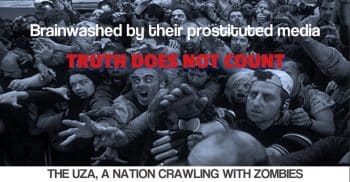 China sees North Korea as a sovereign state that ought to shift more towards a cooperative stance rather than a confrontational one. China like Russia is not happy at the unilateralism pursued by North Korea, not least because neither country want North Korea to be the convenient excuse for US molestation of Asia which China and Russia are a part of but the United States is not.
China sees North Korea as a sovereign state that ought to shift more towards a cooperative stance rather than a confrontational one. China like Russia is not happy at the unilateralism pursued by North Korea, not least because neither country want North Korea to be the convenient excuse for US molestation of Asia which China and Russia are a part of but the United States is not.
